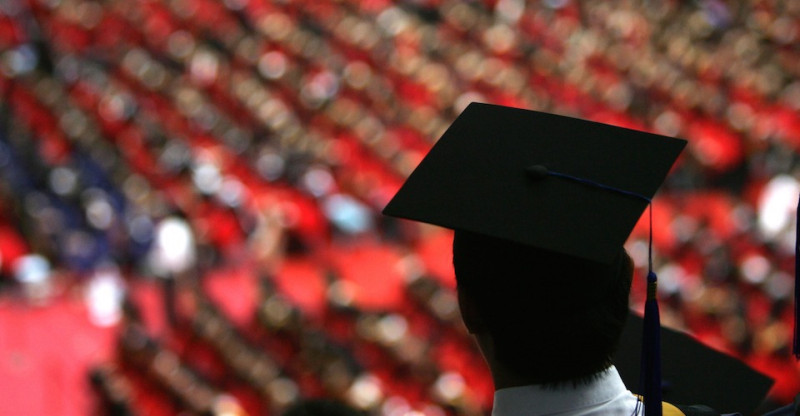KOLB: Why Are American Students So Uneducated?
Charles Kolb | Deputy Assistant to George H.W. Bush
Americans like to talk about K-12 education reform, but lasting accomplishments or significant achievements are few. It’s presidential campaign season now, so expect more education-policy bromides.
For nearly four decades, we’ve experienced waves of education reform (championed by Democrats and Republicans) that have produced little substantive impact on educational performance. International comparisons still show us in the middling range (at best), notwithstanding the fact that we outspend virtually every other nation in the aggregate and, with just a few exceptions, on a per-student basis. The National Assessment of Educational Progress (“NAEP”) results repeatedly show little improvement year after year.
Here’s the trajectory.
Starting in 1983, Ronald Reagan’s first secretary of Education, Terrel Bell, released the now famous “A Nation at Risk” report that characterized American K-12 education as “a rising tide of mediocrity.” William J. Bennett succeeded Bell in 1985 and began issuing annual “Wall Chart” reports listing indicators among the 50 states such as spending, test scores, and graduation rates. The 25 top-ranked states had happy governors; the bottom 25 states had unhappy governors. Bennett’s Wall Chart received enormous annual media coverage, along with his “three Cs” of reform: “content, character, and choice.”
In 1987, education scholars Chester Finn, Jr. and Diane Ravitch co-authored “What Do Our 17-Year-Olds Know?” Using NAEP history and literature assessments, the authors were not encouraging.
With extensive foreign-policy credentials, President George H.W. Bush needed a domestic-policy agenda when he campaigned for president in 1988, so he pledged to be an “education president.” In September 1989, Bush convened 49 governors at a University of Virginia summit that ultimately produced Six National Education Goals.
Bill Clinton, a serious Arkansas education governor, embraced the goals and, as president, added two more goals and highlighted the importance of foreign languages and the arts. To monitor progress, the National Education Goals Panel replaced Bennett’s Wall Chart. The Panel issued tedious annual reports that interested primarily the education-research community. When 2000 arrived, all eight goals remained unmet.
Not to be outdone, President George W. Bush repositioned the education-reform agenda with his easily gamed No Child Left Behind Act and its penalties for poor state performance. By 2014, all American students had to be at least proficient in math and reading. More goals unmet.
President Obama tried to incentivize states with his cumbersome Every Student Succeeds Act plus a well-intentioned effort to establish Common Core Curriculum standards that sparked intense political opposition.
With President Trump, we’re now back to educational choice plus charter schools.
K-12 education policy is simple: if we’re outspending the rest of the world, why aren’t we outperforming the rest of the world? Before we spend more, shouldn’t we first determine how to spend better?
If you consider the top-performing nations on the Program on International Student Assessment conducted every three years by the Paris-based Organization for Economic Cooperation and Development, it’s clear that leading performers Singapore, Hong Kong, Macau, Canada, and Estonia have far more rigorous education systems. The U.S. ranks 31 out of 70 nations in math, science, and reading.
Many years ago, I discovered a report with an alarming factoid: the typical American fifth grader at home each day spent three to five minutes reading and roughly two hours watching television. It’s no wonder that our children perform poorly: they’re not putting in the time. Flip those time allocations and watch performance rise.
The Education Trust also reported a few years ago that nearly a quarter of the high-school graduates taking the Army entrance exam flunked the test. This exam included the equivalent of second-grade math questions. Why are we awarding high-school diplomas to 12th graders who can’t do second-grade math?
We pursue education fads while sidestepping rigor and academic excellence. Social promotion is a recipe for disaster for those students affected by it and for our nation. Other nations, including countries that we used to consider Third World nations, understand the importance of strong educational performance.
It’s time to abandon the process reforms and the fads in favor of a K-12 system that emphasizes time on task, measurable performance standards, and, yes, a common curriculum that reflects what our high school students should know and be able to do when they graduate. Call it tough love, but it’s worth a try.
Reading, writing, and arithmetic still constitute the basics. Perhaps it’s now time to add some rigor.
Charles Kolb was deputy assistant to the president for domestic policy in the George H.W. Bush White House from 1990-1992. From 1997-2012, he was president of the nonpartisan, business-led think tank, the Committee for Economic Development.
Read more: https://www.dailycaller.com/2019/06/11/kolb-american-students/
Content created by The Daily Caller News Foundation is available without charge to any eligible news publisher that can provide a large audience. For licensing opportunities of our original content, please contact licensing@dailycallernewsfoundation.org.


